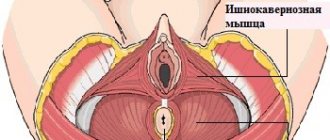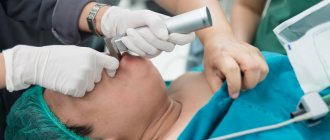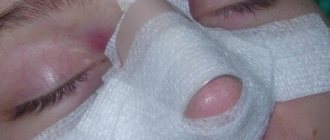Call the clinic +7 928 828 4001
Prices for services
| Service | Price |
| Consultation with a gynecologist | 1350* ք |
| Installation of a pessary | 1350* ք |
| Surgical defloration | 10800* ք |
| Removal of vaginal vestibule cyst | 7200* ք |
| Hymenoplasty | 19800* ք |
| Plastic surgery of the posterior vaginal wall | 18000* ք |
| Plastic surgery of the labia minora | 18,000* ք |
| Perineal plastic surgery | 22500* ք |
Labiaplasty is a branch of laser gynecology for correcting the shape and size of the labia. Every woman wants to be perfect, both for herself and for her significant other. Women are increasingly using the services of cosmetology and plastic surgery. Today, it is possible to solve aesthetic problems in the intimate area; one of the solutions to such problems is labiaplasty, which helps to correct the shape and size of the labia.
What is labiaplasty?
Labiaplasty is an aesthetic transformation of the labia majora and minora, carried out according to the personal wishes of each patient against the background of deformation or traumatic injury, as well as after childbirth. Prices for labiaplasty in Podolsk at the SOLEI Clinic start from 21,000 rubles, combined with the highest level of aesthetic plastic surgery and a soft reconstructive effect.
The technique distinguishes between augmentation and reduction plastic surgery, depending on the type of deformation and the degree of change in the aesthetics of the labia. After labiaplasty, patients are guaranteed complete anonymity when visiting the clinic, fast rehabilitation with no risk of postoperative complications, and an amazing transformation of the intimate area.
When to use labiaplasty:
If it is necessary to change the size of the labia minora and majora Make the labia symmetrical Desire to correct age-related changes It is worth remembering that asymmetry or enlarged labia can lead a woman to become withdrawn due to lack of self-confidence; she will not enter into a relationship, as a result of which she will not be able to find your happiness and may remain lonely. Indications:
- Asymmetry of the labia minora
- The labia minora are elongated
- Protruding labia minora
- Too large labia
- Age-related changes, the appearance of sagging labia
- labia too small.
- Lips that protrude more than 3 centimeters beyond the edges of the labia majora are considered hypertrophied. This problem is one of the most common.
Labiaplasty is used more for aesthetic reasons, since unattractive or asymmetrical labia cause psychological pressure. Labiaplasty can change the shape and size of the labia. Contraindications:
- Low level of blood clotting.
- Age up to 18 years.
- Inflammation in the genitals.
- Tumors.
- Venereal diseases.
Before any operation, it is necessary to undergo examinations, labiaplasty is no exception, and consult with a surgeon and attending physician. It should be recalled that labiaplasty is not advisable for women who have not given birth. Required blood tests for labiaplasty:
- HIV.
- Syphilis.
- Hepatitis B.
- Hepatitis C.
- Flora smear.
Features of anatomy
The labia are external and internal labial folds necessary to protect the internal organs of the urogenital tract from factors of external aggression (trauma, infection, foreign particles, etc.).
The intimate area undergoing deformation changes after a certain age requires cosmetic labiaplasty, the price for which in Podolsk in our Clinic depends on the type and volume of surgical intervention.
The labia majora are lined on the outside with keratinizing epithelium, a fairly dense layer of dermis and a subcutaneous fat layer. Adipose tissue plays an important role in protecting the intimate area from injury, blood flow disturbances due to prolonged sitting or mechanical damage during intense walking.
The labia minora frame the vestibule of the vagina and the anatomical structures located in this area. With total or focal hypertrophy, labiaplasty prevents infection, injury or other damage to the vaginal vestibule.
Dense accumulations of neural endings of the internal labial folds increase erogenous innervation during intimate life.
Muscle and connective tissue fibers, weakly expressed in the labia, are located under the hypodermis layer and are designed to maintain tone and shape. Abundant blood supply to the intimate area and the entire urogenital diaphragm is provided by a dense network of microcapillaries located in the dermal layer. Due to this, the sutures after labiaplasty completely dissolve and become completely invisible even during a professional gynecological examination.
Features of the rehabilitation period after labiaplasty
Typically, recovery after labiaplasty is good. The total duration of the postoperative period is 10-14 days. In this case, there is no need to spend time in the hospital: 2-3 hours after the end of the operation, the woman can be discharged home. Before discharge, the doctor will carefully tell you about all the activities that are important to follow.
The first two days after labiaplasty are recommended to spend as much time as possible in bed. This will help you recover faster and reduce swelling. External swelling can last up to 14-20 days, this is not a reason to panic. Hidden swelling completely disappears a month after labiaplasty. It is worth noting that the greater the volume of manipulations performed, the longer the swelling persists. For example, if during the procedure a woman had her clitoral hood corrected, the recovery period will be increased.
Your attending physician will provide precise advice and recommendations on how to relieve swelling and treat the operated area. Compliance with them contributes to a speedy recovery. During the rehabilitation period, it is important to completely avoid going to the bathhouse, sauna and swimming pool.
Labiaplasty and alcohol
It is not recommended to drink alcohol during the entire rehabilitation period. This is due to the fact that alcohol-containing drinks impair blood circulation, can negatively affect the effect of painkillers and antibiotics, and also provoke even greater swelling. Tissue regeneration requires a lot of resources from the body; if you interfere with it, the rehabilitation period will be delayed.
Sports and sex after labiaplasty
After surgery, lifting weights and playing sports is prohibited for the first time. Restrictions during the recovery period also apply to intimate life. The patient is given sutures made of absorbable biodegradable thread. The resorption period takes about 10-14 days. Depending on the length of the stitches and their number, not all the threads will fall off, so it is recommended to come to the clinic after 2 weeks and remove the remaining stitches. After the sutures are removed, another 7 days of rest are required for final recovery. After this, it is allowed to resume sexual activity.
Useful tips
If after surgery you feel severe pain that prevents you from even touching your genitals, it is important to immediately seek help from a doctor. Minor soreness in the first days is the norm, but if it does not go away and only intensifies, this is an alarm bell. Also, the reason for visiting the clinic is strong pulsation of the labia, the appearance of pus in the wound and the formation of a large hematoma. Otherwise, there is a high probability of developing a severe infection and changing the aesthetic result for the worse. In rare cases (if recommendations are not followed during the postoperative period), the suture may come apart and bleeding will occur. It is necessary to immediately contact a specialist who will apply a new suture so as not to spoil the expected result.
Why does deformation of the intimate area occur?
The reasons affecting the shape, size and proportions of the labia are extremely diverse. Dr. Sergey Anatolyevich Demin is the capital’s leading labiaplasty surgeon and has extensive experience in reconstructive surgeries of the intimate area in women. As a result of treatment, patients are guaranteed restoration of an aesthetic appearance, short rehabilitation and even increased sensitivity.
Labiaplasty surgery is indicated for deformities resulting from:
- age-related changes
- severe weight loss or weight gain
- birth ruptures
- injuries
- transferred operations
- hormonal changes.
An important role when performing labiaplasty is genetic predisposition, in particular to hyperextensibility of connective tissue. Against the background of hyposynthesis of fibrinogen, collagen and elastin by reticulocytes, gradual stretching, deformation of the small labial folds and their drooping occur. Reviews after labiaplasty demonstrate an increase in the production of natural collagen due to the restoration of normal pericapillary blood flow.
Similar processes occur during physiological aging - impaired blood circulation, hypofunction of reticulocytes and a gradual decrease in fibrinogen lead to loss of elasticity of connective tissue and contractility of muscle fibers. Every woman who is unsure of the attractiveness of the intimate area should undergo labiaplasty. Due to the rapid restoration and scarless healing of tissue, this operation is a priority among aesthetic plastic surgery.
Labiaplasty: recovery after surgery
Labiaplasty (labiaplasty) can improve the aesthetics of the intimate area and make a woman’s daily life more comfortable.
Dissatisfaction with the appearance of the genitals has a negative impact on a woman’s self-esteem and intimate life. In addition, too large lips cause physical discomfort for a girl: they make it difficult to ride a bike and play sports, and cause discomfort when wearing tight-fitting trousers. Enlargement of the labia can be caused by a number of factors, in particular, hormonal imbalances, injuries and age-related changes in the body. To eliminate the problems that have arisen against this background, many resort to labiaplasty; the postoperative period does not take much time. Let's take a closer look at what makes it special.
Indications for intimate plastic surgery
Labiaplasty will help prevent a decrease in the sensitivity of the labial folds against the background of severe deformation processes. Before and after photos of clients of our leading plastic surgeon can be viewed during an in-person consultation; the results reflect the minimum degree of surgical correction and an amazing transformation!
Indications for labiaplasty are:
- hypertrophy II and III degrees
- hypoplasia
- asymmetry
- decreased elasticity
- color changes
- violation of proportions
- pronounced disharmonious prolapse
- ruptures after childbirth.
Subjective indications for surgery are pain and discomfort during sexual intercourse, associated with an increase or excessive decrease in the labial folds. A decrease in innervation negatively affects the psychological status, blocks sexual activity and reduces a woman’s quality of life.
Labiaplasty of the labia minora in Podolsk at the SOLEI Plastic Surgery Clinic is performed not only as a single operation, but is also included in the combined plastic surgery of the vaginal walls, vulva and vestibule. Carrying out complex operations increases the period of postoperative rehabilitation, however, it allows you to achieve amazing reconstructive results.
Classic or laser labiaplasty is performed only after a thorough examination of the patient. The examination takes no more than a week and is aimed at identifying contraindications that can provoke postoperative complications.
Progress of labiaplasty surgery
The operation lasts about an hour. It is possible to perform it under local or general anesthesia, the choice is given to the woman, but do not forget that local anesthesia is less stress for the body. When the operation is performed under local anesthesia, the woman can go home faster, and when labiaplasty is performed under general anesthesia, it is necessary to stay at the clinic until the anesthesia wears off completely. During the operation, the surgeon makes the labia as natural as possible. The surgeon also tries to preserve the sensitivity of the lips as much as possible. Women more often seek surgery on the labia minora. During the operation, excess tissue is removed and the edges are aligned. Self-absorbing sutures are placed at the incision sites, which will disappear after a few weeks. Laser surgery performed in our clinic takes significantly less time. Laser labiaplasty allows for more precise correction of the labia. Laser surgery has a number of advantages over traditional surgery. Rehabilitation after labiaplasty is approximately 10 days and is much easier for women to tolerate. There are many fewer complications after laser labiaplasty. Bleeding occurs much less frequently. The appearance of edema and various types of inflammation is minimal. They are minimized as a result of tissue cauterization. Labiaplasty is suitable for both reduction and enlargement of the labia minora and labia majora.
Postoperative period After labiaplasty, antibiotics are prescribed for 7 days, and sutures must also be treated daily. After the operation, the sutures may bother you for 4 weeks; after this period, the sutures usually dissolve. After three months, the scars formed by the sutures disappear. The recovery period after laser surgery is 10 days. After labiaplasty, you should not sit for some time and wear tight-fitting underwear so that the stitches do not come apart and the initially planned result is achieved.
Preparation for labiaplasty
Due to the high demands on the professionalism and exquisite work of surgeons, not every metropolitan clinic performs reconstructive labiaplasty surgery. The price in our Clinic starts from 21,000 rubles, combined with a guaranteed transformation effect, a beneficial effect on the psychological state of a woman and the absence of long-term rehabilitation.
Preparation begins with an initial consultation, during which the doctor, with special tact and delicacy, asks the patient about existing problems. The survey allows you to determine when the first unpleasant changes occurred and whether they were accompanied by any symptoms or concomitant pathologies.
When the doctor finds out the reason why a woman needs labiaplasty, photos of operated patients shown to her help to make sure that the operation is necessary and make the right decision. Then the doctor issues referrals for a diagnostic minimum, which includes:
- laboratory tests (blood, urine)
- ultrasound examination of the urogenital area
- gynecological examination with collection of smears for analysis
- fluorography
- ECG.
After the examination, the doctor selects the date when labiaplasty will be performed, before and after which the patient is required to be examined by a gynecologist. This is important for the early detection of inflammatory lesions of the vaginal walls and labial folds, as well as fungal infections.
Duration of labiaplasty surgery
How long labiaplasty of the labia minora lasts depends on the experience of the surgeon and the patient’s situation. On average, the intervention lasts about an hour. In this case, approximately half of the time is spent on preoperative markings along which the tissue will be excised.
At what age can you have surgery? The intervention is easily tolerated by the body, as it does not involve general anesthesia, and therefore has virtually no age limits.
In Russia, a girl can make her own decision about aesthetic correction after 18 years; there is no upper age limit.
Contraindications
After a comprehensive examination, in the absence of contraindications, labiaplasty is performed; patient reviews note our attentive approach, maintaining complete anonymity and support at every stage of treatment. Regular examinations after labiaplasty are required to monitor the healing process and resorption of sutures.
Contraindications are:
- bacterial infection (acute and exacerbation of chronic)
- mycoses
- candidiasis of the urogenital tract
- acute cystitis
- exacerbation of hemorrhoids
- viral infection
- decompensated heart failure
- pathology of kidney function
- chronic somatic disease in the acute stage.
Labiaplasty is not performed on women during pregnancy and throughout the lactation period. Allergic intolerance to anesthesia drugs and disruption of the blood clotting system are also contraindications. The presence of these deviations significantly increases the risk of various complications after labiaplasty.
Types of labiaplasty
Thanks to modern advances in aesthetic surgery, labiaplasty has several modifications, which allows you to personalize the approach to patients. Our clinic in Podolsk uses only innovative surgical treatment techniques that meet European standards and the latest generation of surgical equipment.
Plastic surgery of large labial folds has different types:
- reducing (liposuction, lifting)
- enhancing (lipofilling, filler injections).
Types of plastic surgery for small labial folds:
- classical technique
- laser
- linear
- V-shaped.
The type of technique is determined by the attending doctor after a comprehensive examination and gynecological examination; this helps to achieve remarkable transformation results and stable preservation of the resulting aesthetic effect. The clinic uses the latest drugs for local and general anesthesia, which have undergone extensive clinical studies and have a proven level of safety.
Reduction of large labial folds
In case of hypertrophy or uneven reduction of the fat layer of the labia majora after significant weight loss, reduction plastic surgery is performed. The operation is aimed at liposuction removal of fat from the areas of greatest accumulation, after which in many cases additional vertical lifting is required.
Liposuction is one of the most minimally invasive procedures that allows you to preserve the integrity of soft tissues, which is especially important during operations on the intimate area. Along the contour of the natural femoral-pubic fold, the doctor makes several punctures using a special cannula and, gently moving muscle and connective tissue fibers along the way, removes excess fat granules.
With grade III hypertrophy, a slightly larger volume of liposuction is required, after which surgical tightening of the skin of the labia majora is indicated. Lifting is carried out using two methods:
- vertical
- horizontal.
Vertical lifting of large labial folds begins with making a continuous incision at the site of the transition of the keratinizing epithelium into the mucous membrane. Thus, no scar remains after the operation due to the abundant vascularization of the mucous layer.
After making incisions on both lips, the doctor manually removes the remaining fat granules, connective tissue bridges and creates a movable skin flap using blunt bougienage. Blunt detachment of the underlying tissue without surgical incisions, according to clinical studies, promotes rapid tissue healing in the postoperative period.
Once the movable portion of the flap is formed, the doctor begins to pull the skin toward the incision, creating a natural tension on the epidermal tissue covering the labia majora. The possibility of gradual tension on both sides ensures symmetry and harmonious arrangement of folds in relation to each other.
The deep tissues are sutured with a longitudinal continuous suture, over which a self-absorbing transcutaneous suture is applied. After vertical labiaplasty, minor pain and swelling of the intimate area persist for the first day.
Horizontal lifting of the outer lips is practically not used in aesthetic surgery today due to volumetric tissue damage and scar changes during the recovery period. The incision in this case is made perpendicular to the directions of the labial folds, tissue tension occurs simultaneously in several directions.
Recovery after a horizontal lift takes a much longer period of time and is accompanied by swelling and pain. The advantage of the method is the possibility of tightening in older women, when the drooping of large labial folds cannot be corrected with vertical plastic surgery.
Labiaplasty
Labiaplasty is a surgery that removes excess tissue from the inner labia, also called the labia minora.
Excess tissue (also known as labia minora hypertrophy) can cause pain and discomfort during sex, exercise, and other daily activities. For some women, this is also a source of complexes.
Labiaplasty is indicated for:
- restoration of the normal anatomical structure of the labia minora
- eliminating asymmetry of the labia minora
- reducing hyperpigmentation and excessive folding of the labia minora
- correction of gaping of the vaginal vestibule
- improving aesthetic appeal
Typically, the goal of labiaplasty is to reduce the labia minora so that it is at the same level or medial to the labia majora. This limits the amount of tissue that is visible when standing. Surgery to reduce the size of the labia majora (large outer lips) is called majoroplasty.
PROCEDURE: labia minora or labiaplasty
GOAL: reduce size, eliminate asymmetry, hyperpigmentation and excessive folding of the labia minora
In my practice there are three categories of patients:
- Women who have functional problems due to enlarged or asymmetrical labia minora
- Women who want to improve aesthetics and get rid of complexes
- Women who experience a combination of functional and aesthetic problems
Plastic surgery of the labia minora or labiaplasty is the most popular operation in intimate surgery. Every year the number of labiaplasties performed in the world increases at an incredible rate.
The labia minora (inner labia) can look very different from one woman to another with a variety of shapes, sizes and colors. This variability in anatomy is what makes each person unique. However, many women who are unhappy with the appearance of their labia prefer to change the shape to make it more aesthetically attractive.
METHOD: after preliminary consultation and determination of the required volume of tissue excision, marking, excision and plastic surgery of the labia minora are performed
Labiaplasty is typically an outpatient procedure that usually takes one to two hours.
“Labioplasty, when you know what you’re doing, is not a 15-minute operation!”
There are two main methods of labiaplasty: linear and shaped excision. During the consultation, I will recommend the best option that suits you in terms of aesthetic and functional results.
Using the linear labiaplasty technique, I make one continuous incision along the edge of the labia minora to evenly remove excess tissue, including the outer edges. This is the preferred method if removal of darker pigmented tissue along the edge of the labia minora is desired.
Using the sculpting technique, a V-shaped wedge is removed from the labia minora tissue, and then the remaining tissue is stitched back together, compressing the entire length of the labia minora. This is a more complex procedure, with shorter incisions along the width of the labia rather than along its edge. The results of this technique look more natural and leave a less noticeable scar, but do not address the problem of hyperpigmentation of the edge of the labia minora at all.
I use internal sutures to close wound defects that do not need to be removed after surgery. Scars after surgery are located in the transition zone of the labia minora and are completely invisible.
Labiaplasty is often combined with clitoral hood reduction to reduce the amount of skin around the clitoris, for aesthetic reasons or to improve sexual sensitivity.
One of my favorite combinations is labiaplasty together with lipofilling of the labia majora, since it is this combination that allows you to restore the lost volume of tissue and reduce the area of resection of the labia minora.
ANESTHESIA: local / general / spinal
Depending on your specific surgery, or combination with any other procedures, you will either be completely asleep under general anesthesia, or sedated with local anesthesia in the labia minora area.
The goal is for you to experience no pain or discomfort during surgery.
You will be able to return home after the anesthesia wears off. You will be out of your element, so make sure you have someone to drive you. You can also stay overnight at the clinic, under the supervision of the doctor on duty.
When will you see labiaplasty results and how long will they last?
You will see your results once the swelling subsides. Typically, it takes three months for the swelling to go down, but it can take up to 12 months, depending on your body and hormonal changes.
The results of labiaplasty are permanent, but keep in mind that your body will continue to change as you age. After labiaplasty, you can have a baby, but remember that childbirth can affect the tissue of the labia minora or change its appearance.
What are the pros and cons of labiaplasty?
Pros:
- Labiaplasty can simultaneously solve both functional and aesthetic problems
- Patients who say the procedure was worth it often report increased self-confidence, especially in intimate situations or when wearing swimsuits or other revealing clothing
- Reduced friction after labiaplasty allows you to freely participate in previously painful sports and exercises
Minuses:
- Recovery after labiaplasty is quite long. Typically, women return to their active lifestyle and fitness routine within three to four weeks after surgery, and it may take four to eight weeks before they can resume sexual intercourse
- Irregularities, folds in the skin of the labia and irregular pigmentation or discoloration at the edges of the labia may occur after surgery
- Some women are unhappy with the result. The most common problem is the size of the clitoral hood compared to the rest of the vulva
- Sometimes revision surgery is required
Increase in external labial folds
With a deficiency in the volume of large folds, exposure of the vaginal vestibule and internal structures gradually develops, and the woman experiences constant psychological discomfort and uncertainty. Size enlargement surgery allows you to close deeper-lying organs, create a harmonious relationship between the genital folds and maintain natural proportions. Enlargement is carried out using two methods:
- lipofilling
- fillers.
The main method of augmentation, which is becoming one of the most popular all over the world, is lipofilling . The procedure involves transplanting your own lipid granules from the areas of greatest accumulation without the use of artificial implants. The method has a number of proven advantages, the leading of which is the absence of the risk of autograft rejection.
During lipofilling, fat granules are taken from the areas of the largest deposits (buttocks, thighs, abdomen, sides) using a special thin cannula. The resulting fat extract is purified by centrifugation to remove dead cells and blood elements.
Similar to liposuction punctures, the doctor inserts cannulas into the large labial folds and slowly enlarges them with the patient’s own fat, moving the device from deep to more external areas. Unlike artificial implants, your own fat is evenly distributed in the hypodermal layer, forming physiological fat conglomerates.
Lipofilling is especially relevant when there is a significant volume deficit, when several autograft injections are required - the enlarged labia have a natural shape, harmonious position and swelling. Fillers are used for small volumes of augmentation or individual wishes of the patient.
Fillers are also relevant at focal magnification, in particular in the lower part of the genital folds. Due to the volume of elastic connective tissue accumulations in this area, filler displacement occurs extremely rarely, which guarantees long-term preservation of the aesthetic effect.
The disadvantage of fillers is the risk of movement within the labia with subsequent deformation requiring surgical correction. In terms of technique, injection augmentation with fillers is no different from lipofilling, however, in the case of the latter, recovery proceeds much faster.
Risks
Remember that genital correction is not a cosmetic procedure, but a surgical intervention. Like any operation, there are risks of complications.
Anesthetic
An incorrectly calculated dose of pain medication, an allergic reaction, concomitant diseases (kidney disease, heart failure) - all this affects the general condition after the procedure.
Sensitivity changes
Incorrect actions by medical personnel can disrupt sensations in this area: hypersensitivity or hyposensitivity will appear. Remember that this phenomenon is normal for the first 3-4 months after surgery. Then the sensations should return to normal. If this does not happen, contact the clinic.
Rough edge
Correction of an uneven edge after labiaplasty
Uneven edge after labiaplasty
After labiaplasty, the lips have a scalloped or jagged edge. This indicates that the suture material was not applied correctly or that the sutures did not dissolve after 2-3 weeks of rehabilitation. This phenomenon can also occur with individual intolerance to threads.
Hypercorrection
Labiaplasty after overcorrection
Situation after correction
The surgeon removed too much tissue, exposing the vaginal opening and clitoris. An additional operation will be required to correct the situation - MPGs protect the woman’s internal genital organs from pathogenic microorganisms, they must cover the entrance. Otherwise, you may experience vaginal dryness, frequent infections, swelling and high sensitivity of the area.
Remember that labiaplasty in clinics differs and the result depends on the chosen technique and the competence of the surgeon.
Classic resection of internal labial folds
Surgical labiaplasty of the labia minora involves the total removal of excess tissue in cases of severe hyperplasia and prolapse. This occurs after childbirth or increasing age-related changes, occurs in almost every woman and cannot be treated without surgery.
Resection begins with excision of tissue along the contour of the vaginal vestibule using a surgical scalpel. The doctor restores the natural shape and gives a smooth edge to the labia minora. Classic resection allows you to qualitatively transform the intimate area, is included in hymenoplasty and is extremely popular among patients of the clinic.
The loose contours of the inner lips are sutured with a transcutaneous suture using self-absorbable materials. Classic resection is a simple half-hour operation, recovery from which is extremely fast and is not accompanied by pain or swelling.
Types of labiaplasty
Depending on the desired result, labiaplasty involves different manipulations.
Contour plastic
It is performed on an outpatient basis under local anesthesia. The essence of the intervention is the introduction of components that fill the space between the cells, tone the tissues, stimulate the production of its own collagen, and change the shape of the labia if necessary. As a rule, hyaluronic acid is used as injected drugs.
With the help of contour plastic surgery you can achieve:
- changes in the shape of the clitoris and labia,
- stimulation of natural lubrication,
- increasing the sensitivity of the “G” point,
- eliminating age-related changes,
- changes in vaginal volume and depth.
Important! The disadvantage of the procedure is that the effect is temporary. If the problem is pronounced, the manipulation will have to be repeated every year.
Vaginal correction. Most often, a defect in the vaginal walls is a consequence of childbirth or surgery; indications for this procedure are:
- omission;
- presence of scars;
- organ stretching;
- pain and discomfort in the lower abdomen.
Vaginal correction also varies depending on the woman’s age:
- Vaginoplasty is the least traumatic method; it does not deprive a woman of the opportunity to give birth to a child naturally. The stretched tissues are excised, and the muscles are pulled to the anus.
- Reinforcement – recommended for older women. Artificial medical material is sewn into the deformed tissue to lift and hold the vagina.
As an alternative to complex surgery, bidirectional vaginal thread can be used. It is injected into the muscle or skin. This manipulation does not require hospitalization of the patient, gives quick results and has a short rehabilitation period.
Genital plastic surgery
This, in fact, is labiaplasty, which is performed not only for aesthetic, but also for medicinal purposes. The labia are gates that protect the internal genital organs from infection, so this operation is performed for congenital anomalies; in all other cases, it is performed only to add aesthetics.
There are 4 stages of pathology of the labia minora, depending on the length of the protrusion above the labia majora:
- Stage 1 – up to 1 cm;
- Stage 2 – 1-3 cm;
- Stage 3 – 3-5 cm;
- Stage 4 – more than 5 cm.
Intimate clitoral plastic surgery
It is carried out to enlarge or reduce an organ, as well as to change its position. As a result of the operation, a woman not only gets rid of a cosmetic defect, but also gets more pleasure from sexual intercourse.
Intimate plastic defloration
It is carried out if the hymen cannot be ruptured naturally, as well as when its overgrowth provokes an inflammatory process.
Injection restoration
The introduction of hyaluronic acid improves the tone of the labia. It can be inserted not only into the labia, but also into the clitoris. This procedure is recommended after childbirth and when tissue loses elasticity with age.
Fat removal
Removing fat in the pubic area is a purely aesthetic manipulation. The specialist makes punctures through which he injects a special solution to dissolve the fat, and then removes the fat deposits through the conuli. The manipulation does not leave any traces.
Laser labiaplasty
Laser plastic surgery of the internal labial folds reduces the speed of rehabilitation and is used for significant amounts of hypertrophy and severe deformities. Using a laser beam, the doctor excises the delicate tissue, outlining an even contour around the vaginal vestibule.
The laser helps preserve capillary vascularity and nerve endings, which leads to rapid healing and preservation of erogenous sensitivity. The intimate area becomes neat, which has a positive effect on the psychological component, a woman’s confidence and her sexual activity.
Laser labiaplasty is performed on women with postpartum tears or improper suturing in the maternity hospital. The technique helps reduce size, eliminates unpleasant odor, excessive sweating and reduces the risk of injury.
Laser resection also includes de-epitalization of the labia minora with complete removal of the diamond-shaped area of tissue while maintaining the natural edge. This avoids the formation of scars or cicatricial contraction of the small labial folds.
Complications after labiaplasty
It is worth remembering that any surgical intervention can lead to unpleasant consequences and complications. The most common complications are: bruising, inflammation of scar tissue, pain and tightness in the perineum. Also, the disadvantages of women include a long recovery period. To avoid complications during labiaplasty, you must: carefully consider the choice of the specialist who will perform the operation. After the operation:
- The visual component is improved.
- Self-confidence appears.
- Discomfort disappears.
- A woman gets satisfaction in her intimate life.
- Intimate hygiene becomes easier.
- Examination by a gynecologist becomes easier.
- Physical discomfort goes away.
- Psychological stress goes away.
- Results of labiaplasty.
Women who use labiaplasty get rid of many problems. Protruding labia well cause discomfort, the intimate area becomes more attractive, after such an operation women become more self-confident, feeling more beautiful and desirable. The sensations during sexual intercourse remain or become brighter; for most women, psychological stress goes away, as a result of which dissatisfaction with intimate life disappears.
Linear plastic
In surgical plastic surgery, the internal labial fold is sutured using the linear method The doctor makes linear incisions from the upper to the lower edge, retreating 6-8 mm from the base of the fold on the inside.
On each labia, two incisions are made, between which an excess amount of tissue is located - deepening the incisions, the surgeon excises two longitudinal flaps, resulting in the formation of an open wound. The edges of the wound are sutured with a superficial suture from top to bottom, giving the desired shape and position of the inner lips.
Linear plasty is optimal for small volumes of external labial folds, when it is necessary to create a clear, even contour of the small folds. Soft tissues evenly cover the genital opening and take on an aesthetic appearance by improving blood supply and changing color.
V-shaped plastic
Plastic surgery using the “V” method is carried out by making incisions with an expanded base directed towards the edges of the labia minora. Thus, this technique allows you to remove local hypertrophied areas, in particular after childbirth. For example, if the patient exhibits a disharmonious increase in the labial fold with a predominance of the upper, middle or lower segments.
While maintaining the natural edge, the doctor excises the enlarged area without losing the capillary bed and nerve endings. The disadvantage of this method is the risk of scarring, which is noticeable during a gynecological examination.
The rehabilitation process with V-plasty proceeds favorably due to the preservation of the free edge of the labial fold. Patients note a quick return to usual sports activities, recovery without blood, pain or irritation of the intimate area in the postoperative period.
V-shaped plastic surgery also includes S- and W-shaped techniques aimed at increasing the volume of preserved tissue and minimizing the risk of scar adhesions. In addition, with significant surgical resection of the labial folds, these methods eliminate pathological contraction of tissue and overlap of the genital fissure.
Rehabilitation stage
Recovery after surgery on the labial folds proceeds favorably; in most cases, rapid tissue repair occurs without pain, discomfort, itching or bleeding. The risk of hematoma and edema formation is also extremely low; however, the first couple of days after surgery require daily treatment of the intimate area.
Patients are prescribed a course of drug treatment to accelerate the repair processes of granulation tissue and reduce the likelihood of secondary flora joining. It is recommended to limit sitting, active sports and maintain sexual rest until the tissue is completely restored.
Complete rehabilitation lasts up to two weeks, after which the patient begins to gradually return to her usual pace of daily activities without the chance of complications. Compliance with the recommendations of the attending surgeon is extremely important for a favorable course of the rehabilitation period.
Reviews
Diana, 24 years old: “I can’t say that I’ve ever had a beautiful intimate area - there was always a lack somewhere, and there was a lot somewhere. But after giving birth, the problem became simply catastrophic, it became simply embarrassing to be naked in front of my husband, and intimate moments were accompanied by pain. I went to the clinic in the hope of saving my relationship with my beloved husband. Sergei Anatolyevich is an amazingly tactful, sensitive and empathetic doctor. He advised me to undergo plastic surgery, using immediately increasing and decreasing tactics, as well as correction of birth sutures.
The first days it was forbidden to sit, I only lay or walked in the clinic room, basically the same as after giving birth. When I saw the result for the first time, I was scared, it seemed that this was not mine at all...))
I’m very glad that I decided, I thank the doctor with all my heart, my husband is also happy. Thank you!
Myths about labiaplasty
The procedure is surrounded by rumors. Opinions about it are very contradictory: some say that their lives have changed for the better, others have received new problems. The truth, as always, is somewhere in the middle.
Myth 1. This is a painless procedure.
Pain during normal recovery lasts about 5-7 days. Their intensity is very individual: for some it is uncomfortable to go to the toilet, for others it is painful to sit and move. The feeling of tightness, soreness and increased sensitivity may persist for up to 1 month. It is important to be mentally prepared for such a rehabilitation period and wait it out calmly.
Myth 2. The shorter the better.
Removing the MPG completely or excising too much tissue is dangerous. A qualified surgeon will not agree to such a procedure, which will obviously lead to negative consequences and cripple the woman.
The function of the MPG is to protect the entrance to the vagina, therefore it is important to preserve the tissue in normal quantities.
Myth 3. You can’t do it before giving birth.
There are no restrictions for nulliparous patients. The intervention will not affect labor and will not cause additional ruptures. The only thing that may occur is repeated slight lip enlargement during pregnancy or after childbirth, but this is rare. Lengthening occurs because the lip area changes due to the stretching of the perineum.
Myth 4. Laser is easier to tolerate
Each method has its drawbacks. Excision with a scalpel often causes bleeding, but the laser seals the cut line and blood does not flow. But laser removal is not ideal. After it, burns form in the genital area, which take a long time to heal, cause discomfort, and sensitivity decreases. A more predictable result is obtained with a surgical technique - tissue removal with a scalpel.
Myth 5. There will be unsightly seams
In the area of intimate organs, biodegradable suture material is used, which dissolves on its own. This takes about 14-30 days. Very small stitches remain, which are not always noticeable even during a gynecological examination. So the sexual partner will not see the scars and will not know about the procedure.











